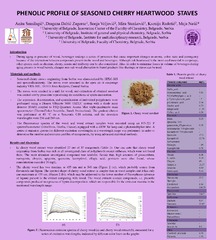Приказ основних података о документу
Fenolni profil duga trešnjinog drveta
Phenolic profile of seasoned cherry heartwood staves
| dc.creator | Smailagić, Anita | |
| dc.creator | Dabić Zagorac, Dragana | |
| dc.creator | Veljović, Sonja | |
| dc.creator | Stanković, Mira | |
| dc.creator | Radotić, Ksenija | |
| dc.creator | Natić, Maja | |
| dc.date.accessioned | 2022-06-14T13:37:02Z | |
| dc.date.available | 2022-06-14T13:37:02Z | |
| dc.date.issued | 2018 | |
| dc.identifier.isbn | 978-86-7522-060-2 | |
| dc.identifier.uri | http://cherry.chem.bg.ac.rs/handle/123456789/5298 | |
| dc.description.abstract | Prilikom starenja alkoholnih pića u prisustvu drveta dolazi do važnih promena u aromi, boji, ukusu i gorčini, usled interakcije između jedinjenja iz drveta i destilata. Iako se hrast najviše koristi za čuvanje alkoholnih pića, i druge vrste, kao što su kesten, trešnja, bagrem i dud, se mogu koristiti. Cilj rada bio je da se okarakteriše ekstrakt duga trešnjinog drveta primenom HPLC-MS i spektrofluorometrijske metode. Dobijeni rezultati ukazali su na to da je stablo trešnje bogato fenolnim jedinjenjima. Spektrofluorometrijski rezultati ukazuju na razliku trešnjinog drveta i njegovog ekstrakta u odnosu na druge vrste drveta, zbog prisustva specifičnih flavonoida u ovom drvetu. Najzastupljenije ispitivano jedinjenje je taksifolin, a pored njega pronađene su značajne količine pinocembrina, naringenina, hrizina, apigenina, kvercetina, kempferola, elaginske kiseline, genisteina, čije su koncentracije bile veće od 10 mg/L. | sr |
| dc.description.abstract | During aging in the presence of wood, beverages undergo a series of processes leading to important changes in aroma, color, taste and astringency because of the interaction between compounds present in the wood and beverages. Although oak heartwood is the most used material in cooperage, other species such as chestnut, cherry, acacia and mulberry can also be considered. The objective of this research was the characterization of seasoned cherry staves by HPLC-MS method and spectrofluorometry. The results showed that cherry wood originating from Serbia was rich in phenolic compounds. Spectrofluorometric results indicate the difference between cherry wood and its extract comparing with other wood species due to the presence of specific flavonoids in this wood. The most abundant investigated compound was taxifolin. Also, significant amounts of pinocembrin, naringenin, chrysin, apigenin, quercetin, kaempferol, ellagic acid, genistein were also found, in concentration higher than 10 mg/L. | sr |
| dc.language.iso | sr | sr |
| dc.language.iso | en | sr |
| dc.relation | info:eu-repo/grantAgreement/MESTD/Basic Research (BR or ON)/172017/RS// | sr |
| dc.relation | info:eu-repo/grantAgreement/MESTD/Integrated and Interdisciplinary Research (IIR or III)/46001/RS// | sr |
| dc.relation | info:eu-repo/grantAgreement/MESTD/Basic Research (BR or ON)/173017/RS// | sr |
| dc.rights | openAccess | sr |
| dc.rights.uri | https://creativecommons.org/licenses/by-nc-nd/4.0/ | |
| dc.source | Unifood Conference University of Belgrade 210th Anniversary Program i zbornik radova Programme & Book of Abstracts | sr |
| dc.subject | HPLC-MS | sr |
| dc.subject | spectrofluorometry | sr |
| dc.subject | phenolics | sr |
| dc.subject | polifenoli | sr |
| dc.subject | spektrofluorometrija | sr |
| dc.title | Fenolni profil duga trešnjinog drveta | sr |
| dc.title | Phenolic profile of seasoned cherry heartwood staves | sr |
| dc.type | conferenceObject | sr |
| dc.rights.license | BY-NC-ND | sr |
| dc.citation.spage | OHP4/FCHP4 | |
| dc.description.other | Abstract: [https://cherry.chem.bg.ac.rs/handle/123456789/5302] | |
| dc.type.version | publishedVersion | sr |
| dc.identifier.fulltext | http://cherry.chem.bg.ac.rs/bitstream/id/29730/bitstream_29730.pdf | |
| dc.identifier.rcub | https://hdl.handle.net/21.15107/rcub_cherry_5298 |


